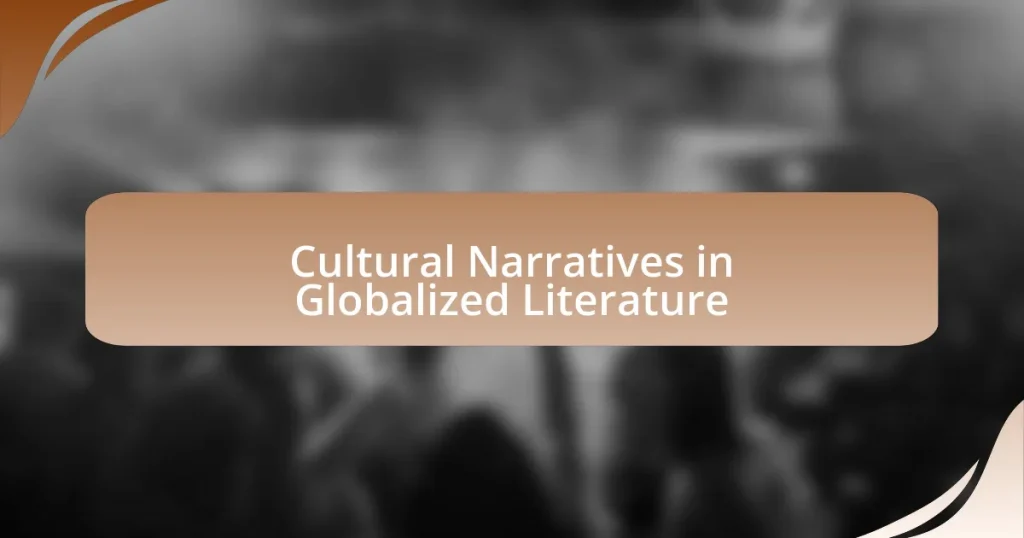Cultural narratives in globalized literature encompass stories that reflect the diverse experiences, values, and identities of various cultures within a global framework. These narratives explore themes such as migration, identity, and cultural exchange, highlighting how globalization impacts local traditions and perspectives. The article examines how cultural narratives shape literary works, influence character development and plot, and reflect societal values, while also addressing the role of historical contexts and the implications of cultural hybridity. Additionally, it discusses the challenges writers face in representing multiple cultures and the significance of postcolonial perspectives in understanding global literature. Through this analysis, the article emphasizes the importance of cultural narratives in fostering cross-cultural understanding and empathy among readers.

What are Cultural Narratives in Globalized Literature?
Cultural narratives in globalized literature are stories that reflect the diverse experiences, values, and identities of various cultures within a global context. These narratives often explore themes of migration, identity, and cultural exchange, illustrating how globalization influences local traditions and perspectives. For instance, authors like Chimamanda Ngozi Adichie and Salman Rushdie incorporate their cultural backgrounds into their works, showcasing the complexities of cultural identity in a globalized world. This blending of narratives allows for a richer understanding of human experiences across different societies, emphasizing the interconnectedness of cultures in contemporary literature.
How do cultural narratives shape literary works in a global context?
Cultural narratives shape literary works in a global context by influencing themes, character development, and narrative structures. These narratives reflect the values, beliefs, and experiences of specific cultures, which authors incorporate into their works to resonate with diverse audiences. For instance, postcolonial literature often explores themes of identity and displacement, drawing from the cultural narratives of colonized societies, as seen in works by authors like Chinua Achebe and Salman Rushdie. Additionally, the globalization of literature allows for cross-cultural exchanges, where authors adapt and reinterpret cultural narratives from different backgrounds, enriching the literary landscape. This interplay between cultural narratives and literature fosters a deeper understanding of global issues, as evidenced by the rise of multicultural literature that addresses themes of migration and cultural hybridity.
What elements define cultural narratives in literature?
Cultural narratives in literature are defined by elements such as identity, tradition, values, and social context. These elements shape the way stories are told and understood within specific cultural frameworks. For instance, identity reflects the characters’ backgrounds and experiences, while tradition encompasses the customs and practices that influence the narrative. Values represent the moral and ethical beliefs that guide characters’ actions, and social context situates the narrative within the historical and cultural circumstances of the time. Together, these elements create a rich tapestry that conveys the complexities of cultural experiences, as seen in works like Chinua Achebe’s “Things Fall Apart,” which illustrates the clash between traditional Igbo culture and colonial influences.
How do cultural narratives influence character development and plot?
Cultural narratives significantly influence character development and plot by shaping the values, beliefs, and behaviors of characters within a story. These narratives provide a framework through which characters are understood, often reflecting societal norms and historical contexts. For example, in literature from post-colonial societies, characters may embody the struggles against colonialism, illustrating themes of identity and resistance, which are central to the cultural narrative of that era. This influence is evident in works like Chinua Achebe’s “Things Fall Apart,” where the protagonist’s journey is deeply intertwined with the cultural upheaval of colonialism in Nigeria, demonstrating how cultural narratives drive character motivations and plot progression.
Why are cultural narratives important in understanding global literature?
Cultural narratives are important in understanding global literature because they provide context and meaning to the stories being told. These narratives shape the identities, values, and beliefs of different cultures, influencing how literature is created and interpreted. For instance, the themes of colonialism in postcolonial literature reflect the cultural narratives of oppression and resistance, as seen in works like Chinua Achebe’s “Things Fall Apart,” which illustrates the impact of European colonization on African societies. By analyzing these narratives, readers gain insights into the diverse perspectives and experiences that inform global literature, enhancing their comprehension and appreciation of the texts.
What role do cultural narratives play in reflecting societal values?
Cultural narratives serve as a mirror to societal values by encapsulating the beliefs, norms, and practices of a community. These narratives, found in literature, folklore, and media, reflect what a society prioritizes, such as family, honor, or individualism. For instance, in many Indigenous cultures, narratives emphasize the interconnectedness of nature and humanity, showcasing a value system that prioritizes environmental stewardship. This is evident in works like “The Round House” by Louise Erdrich, which explores themes of community and justice within Native American contexts. Such narratives not only convey cultural identity but also influence societal behavior and attitudes, reinforcing or challenging existing values.
How do cultural narratives contribute to cross-cultural understanding?
Cultural narratives enhance cross-cultural understanding by providing insights into the values, beliefs, and experiences of different societies. These narratives, often conveyed through literature, art, and oral traditions, allow individuals to empathize with perspectives outside their own cultural context. For instance, studies show that reading literature from diverse cultures can increase empathy and reduce prejudice, as evidenced by research conducted by Mar et al. (2006) in “Reading Literary Fiction Improves Theory of Mind.” This demonstrates that engaging with cultural narratives fosters a deeper appreciation of the complexities of human experience across various cultures.

How has globalization impacted cultural narratives in literature?
Globalization has significantly transformed cultural narratives in literature by facilitating the exchange of diverse perspectives and themes across borders. This exchange allows authors to incorporate elements from various cultures, leading to hybrid narratives that reflect a more interconnected world. For instance, the rise of postcolonial literature showcases how writers from formerly colonized nations blend indigenous storytelling traditions with Western literary forms, creating unique narratives that challenge dominant cultural paradigms. Additionally, the accessibility of global literature through digital platforms has enabled readers to engage with a wider array of voices, further enriching the literary landscape. This phenomenon illustrates how globalization not only broadens the scope of cultural narratives but also fosters a dialogue between different cultural identities, ultimately reshaping the way stories are told and understood.
What changes have occurred in storytelling due to globalization?
Globalization has transformed storytelling by facilitating the cross-cultural exchange of narratives, leading to diverse influences and hybrid storytelling forms. This shift allows for the blending of traditional and contemporary elements, as seen in works that incorporate multiple cultural perspectives, such as Chimamanda Ngozi Adichie’s “Americanah,” which explores themes of identity and migration. Furthermore, globalization has increased access to various media platforms, enabling stories from different cultures to reach wider audiences, exemplified by the global popularity of anime and K-dramas. This interconnectedness fosters a richer narrative landscape, where stories reflect a more globalized human experience.
How do authors incorporate diverse cultural perspectives in their narratives?
Authors incorporate diverse cultural perspectives in their narratives by integrating authentic cultural experiences, utilizing varied narrative techniques, and including characters from different backgrounds. For instance, authors often conduct thorough research or engage with communities to accurately portray cultural practices, beliefs, and values, which enhances the authenticity of their narratives. Additionally, techniques such as multiple viewpoints or non-linear storytelling allow for a richer exploration of cultural contexts. A notable example is Chimamanda Ngozi Adichie’s “Americanah,” which examines race and identity through the lens of Nigerian and American cultures, illustrating the complexities of cultural intersections. This approach not only broadens readers’ understanding but also fosters empathy and appreciation for diverse experiences.
What challenges do writers face in representing multiple cultures?
Writers face significant challenges in representing multiple cultures, primarily due to the risk of cultural appropriation and misrepresentation. Cultural appropriation occurs when writers adopt elements from a culture without understanding or respecting its significance, which can lead to stereotypes and inaccuracies. For instance, a study by the American Psychological Association highlights that misrepresentation can perpetuate harmful stereotypes, affecting how cultures are perceived globally. Additionally, writers may struggle with authenticity, as they must balance their own perspectives with the need to accurately portray the experiences and voices of individuals from different cultures. This challenge is compounded by the potential backlash from communities who feel their culture is being misrepresented or oversimplified.
In what ways does globalization affect the reception of cultural narratives?
Globalization affects the reception of cultural narratives by facilitating the cross-cultural exchange of ideas, leading to a broader audience and diverse interpretations. This exchange allows narratives from one culture to be accessed and appreciated by individuals from different backgrounds, often resulting in hybrid forms of storytelling that blend elements from multiple cultures. For instance, the global popularity of Japanese anime has influenced Western animation styles, demonstrating how cultural narratives can evolve through globalization. Additionally, studies show that exposure to diverse cultural narratives can enhance empathy and understanding among audiences, as seen in the increased consumption of international films and literature in the 21st century.
How do readers from different backgrounds interpret cultural narratives?
Readers from different backgrounds interpret cultural narratives through the lens of their unique experiences, values, and social contexts. This interpretation is influenced by factors such as ethnicity, socioeconomic status, education, and personal history, which shape how individuals relate to and understand the themes and characters presented in the narratives. For instance, a study by Kearney and McCarthy (2019) in the Journal of Cultural Studies found that readers from marginalized communities often resonate more deeply with narratives that reflect their struggles and identities, leading to a more empathetic engagement with the text. Conversely, readers from dominant cultural backgrounds may interpret the same narratives through a different framework, often focusing on universal themes rather than specific cultural nuances. This divergence in interpretation highlights the importance of context in understanding cultural narratives, as evidenced by research indicating that cultural familiarity can enhance comprehension and emotional connection to the story.
What impact does technology have on the dissemination of cultural narratives?
Technology significantly enhances the dissemination of cultural narratives by enabling rapid and widespread sharing across diverse platforms. Digital media, such as social networks, blogs, and streaming services, allow cultural stories to reach global audiences instantly, breaking geographical barriers. For instance, platforms like YouTube and Instagram facilitate the sharing of cultural expressions, leading to increased visibility and engagement with various cultural narratives. According to a 2020 Pew Research study, 72% of adults in the U.S. use social media, which amplifies the reach of cultural content and fosters cross-cultural exchanges. This technological influence not only democratizes access to cultural narratives but also encourages the blending and evolution of these narratives in a globalized context.

What are the key themes in cultural narratives within globalized literature?
Key themes in cultural narratives within globalized literature include identity, migration, hybridity, and cultural conflict. These themes reflect the complexities of human experience in a globalized world, where individuals navigate multiple cultural identities and face challenges related to displacement and belonging. For instance, the theme of identity often explores how globalization influences personal and collective identities, as seen in works like Chimamanda Ngozi Adichie’s “Americanah,” which examines the nuances of race and nationality. Migration is another prevalent theme, highlighting the experiences of individuals who move across borders, as depicted in Khaled Hosseini’s “The Kite Runner,” where the protagonist’s journey reflects the impact of war and exile. Hybridity showcases the blending of cultures, often resulting in new forms of expression, while cultural conflict addresses the tensions that arise from differing cultural values and practices, evident in novels like “The Brief Wondrous Life of Oscar Wao” by Junot Díaz. These themes collectively illustrate the dynamic interplay of cultures in a globalized context, shaping narratives that resonate across diverse audiences.
How do themes of identity and belonging manifest in global literature?
Themes of identity and belonging manifest in global literature through the exploration of characters’ struggles with cultural heritage, personal history, and societal expectations. For instance, in Chimamanda Ngozi Adichie’s “Americanah,” the protagonist navigates her Nigerian identity while adapting to life in the United States, highlighting the complexities of belonging in a multicultural context. Similarly, Khaled Hosseini’s “The Kite Runner” illustrates the impact of ethnic identity and personal relationships on belonging, as the characters grapple with their pasts in Afghanistan. These narratives often reflect broader societal issues, such as migration, displacement, and the quest for self-acceptance, demonstrating how literature serves as a mirror to the diverse experiences of identity and belonging across cultures.
What are the implications of cultural hybridity in narratives?
Cultural hybridity in narratives implies a blending of diverse cultural elements, resulting in enriched storytelling that reflects multiple perspectives. This blending allows for the exploration of identity, power dynamics, and social issues, as seen in works like Salman Rushdie’s “Midnight’s Children,” which intertwines Indian history with magical realism. Such narratives challenge traditional boundaries, fostering cross-cultural understanding and dialogue, as evidenced by the increasing popularity of hybrid genres in global literature.
How do themes of migration and displacement shape storytelling?
Themes of migration and displacement profoundly shape storytelling by providing rich narratives that explore identity, belonging, and cultural conflict. These themes allow authors to depict the emotional and physical journeys of characters who navigate new environments, often highlighting the struggles and resilience associated with leaving one’s homeland. For instance, literature such as “The Kite Runner” by Khaled Hosseini illustrates the impact of displacement on personal relationships and cultural identity, showcasing how migration can lead to both loss and growth. Furthermore, studies indicate that narratives centered on migration often reflect broader societal issues, such as globalization and the refugee crisis, thereby fostering empathy and understanding among diverse audiences.
What role do historical contexts play in shaping cultural narratives?
Historical contexts significantly influence cultural narratives by providing the backdrop against which stories are told and understood. These contexts encompass events, social movements, and prevailing ideologies that shape the values and beliefs of a society. For instance, the impact of colonialism on literature is evident in works like Chinua Achebe’s “Things Fall Apart,” which reflects the complexities of Nigerian identity during British colonial rule. Such historical events inform the themes, character development, and moral dilemmas presented in narratives, allowing readers to grasp the cultural significance embedded within the text. Thus, historical contexts serve as a critical lens through which cultural narratives are interpreted and appreciated.
How do past events influence contemporary literary themes?
Past events significantly shape contemporary literary themes by providing context, inspiration, and moral frameworks for writers. Historical events, such as wars, social movements, and cultural shifts, often serve as backdrops for narratives, influencing character development and plotlines. For instance, the impact of World War II is evident in post-war literature, where themes of trauma, loss, and identity are explored, as seen in works like “Slaughterhouse-Five” by Kurt Vonnegut. Additionally, the civil rights movement has inspired contemporary authors to address issues of race and justice, as reflected in novels like “The Hate U Give” by Angie Thomas. These examples illustrate how past events inform the thematic concerns of modern literature, allowing authors to engage with ongoing societal issues and resonate with readers through shared historical experiences.
What is the significance of postcolonial perspectives in global literature?
Postcolonial perspectives are significant in global literature as they provide critical insights into the effects of colonialism on cultures, identities, and narratives. These perspectives challenge dominant Western narratives, highlighting the voices and experiences of colonized peoples, which fosters a more inclusive understanding of history and culture. For instance, authors like Chinua Achebe and Salman Rushdie illustrate how colonial legacies shape contemporary identities and conflicts, thereby enriching the global literary landscape. By examining themes of hybridity, resistance, and identity, postcolonial literature not only critiques colonial power structures but also promotes cultural diversity and dialogue in a globalized world.
What practical insights can be drawn from analyzing cultural narratives in globalized literature?
Analyzing cultural narratives in globalized literature reveals insights into identity formation, cultural hybridity, and the impact of globalization on local traditions. These narratives often illustrate how individuals and communities negotiate their identities in a rapidly changing world, reflecting the blending of diverse cultural influences. For instance, literature from post-colonial contexts frequently showcases characters grappling with their heritage while adapting to global cultural trends, highlighting the complexities of belonging. Furthermore, studies indicate that such narratives can foster empathy and understanding among readers by presenting multiple perspectives on shared human experiences, as seen in works like Chimamanda Ngozi Adichie’s “Americanah,” which explores themes of race and identity across different cultural landscapes.
How can readers enhance their understanding of diverse cultures through literature?
Readers can enhance their understanding of diverse cultures through literature by engaging with texts that represent various cultural perspectives and experiences. This engagement allows readers to gain insights into the values, beliefs, and social norms of different communities. For instance, novels like “Things Fall Apart” by Chinua Achebe provide a deep exploration of Igbo culture and its complexities, illustrating the impact of colonialism on traditional societies. Additionally, studies show that reading literature from diverse authors can foster empathy and cultural awareness, as highlighted in research by the National Endowment for the Arts, which found that literature can improve understanding of others’ experiences and viewpoints. Thus, through the exploration of varied narratives, readers can cultivate a more nuanced appreciation of global cultures.
What strategies can writers use to effectively convey cultural narratives?
Writers can effectively convey cultural narratives by employing strategies such as immersive storytelling, authentic character development, and the use of cultural symbols. Immersive storytelling allows writers to create vivid settings and experiences that reflect the cultural context, enabling readers to engage deeply with the narrative. Authentic character development involves crafting characters that embody the complexities of their cultural backgrounds, which fosters relatability and understanding. The use of cultural symbols, such as traditional practices or language, enriches the narrative and provides readers with insights into the cultural significance behind these elements. These strategies are supported by research indicating that narratives grounded in cultural authenticity resonate more with audiences, enhancing their connection to the story and its themes.










